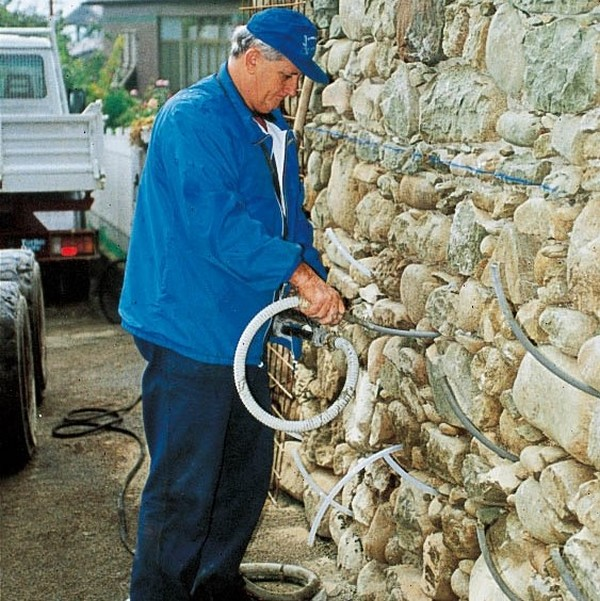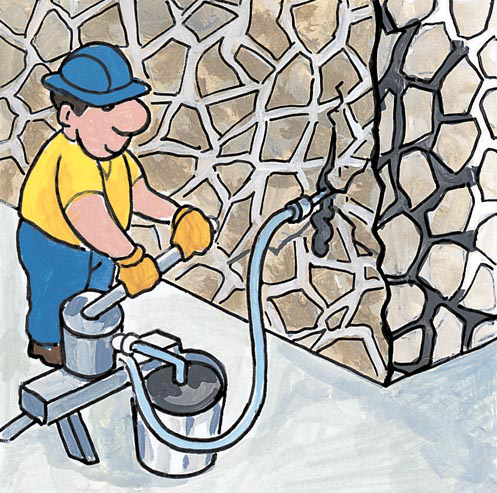



"• Extremely low hydration heat; • High water vapour permeability; • Low elastic modulus; • Good mechanical resistance with slow and gradual mechanical resistance development; • High support adhesion; • Extremely fine binders and aggregates that allow high penetration crack and porous injections; • Well-distributed structural consolidation and rebalancing across the entire masonry body; • Compatibility with antique plasters and traditional materials; • No expansive crystallization reactions or rejection by standard antique masonry materials; • Absolutely no bleeding (mix water separation)."
"Mikrosana is used for consolidating and re-adhesive injections of antique and frescoed plasters and as a grout for consolidation and rehabilitation injections of brick, stone and mixed structures. Particularly recommended for antique wall structures with issues of compatibility between wall structure components and standard cement-based or epoxy-based reinforcement injections. When applying consolidating injections in sizeable antique masonry volumes, it is recommended to avoid: • The hardening of some injected areas faster than others (e.g. use of rapid hardening cement) • Water vapour barriers that interfere with the normal breathability of the wall structure (e.g. use of epoxy resin injections); • Stressing the wall structure with excessive heat build-up during the hardening of binding mixtures (e.g. use of extra-fine Portland cement). • Chemical incompatibility with materials in the wall structure (e.g. potential formation of sulfoaluminates, such as ettringite and thaumasite, from the reaction between sulphates in the wall structure and Portland cement)."
"Before consolidating injections, joint grouting and masonry cracks must be sealed to prevent the injected material from leaking out. This can be done in the following ways: • By providing, if plastering, a Untersana rendering coat or plaster made on site using the natural hydraulic lime CALCESANA; • By performing, if the masonry is to left exposed, perfect pointing of joints and discontinuities (e.g. cracks, dents, gaps) with one of the following mortars: Sanazieg, Sanalink or Unisan (to be chosen depending on the structural needs and characteristics of the antique mortars in the wall structure). After sealing the discontinuities, make a pattern of holes, with a slightly downward incline, in correspondence with the mortar joints. Usually 4-6 holes are made per square metre with approximately 50cm separation and 20mm diameter. However, the exact arrangement and diameter of holes, angle of inclination, depth of penetration and any reinforcement of holes is to be decided by the designer and works manager, according to decisions based on structure type, degradation and intended result. After blowing out disintegrated mortar and dust, wet the holes with water. Then insert plastic tubes (diameter 10 to 30 mm as needed) to convey the injection mixture well inside the holes. The tubes must be fixed to the masonry with one of the following mortars: Sanazieg, Sanalink or Unisan."
Mixing: Mixing Mikrosana must be done with a high-efficiency mechanical mixer (e.g. double-helix whisk with speed variator), starting mixing at low speed, gradually increasing the speed up to a speed > 300 rpm and respecting the minimum/maximum water proportions (from 23% to 26% referred to the weight of the premix) and mixing for at least three minutes. Mikrosana acquires its exceptional flow characteristics only after effective mixing. Mix for at least 3 minutes, let the mixture rest for one minute and perform a final mix for a further minute. Once the correct workability has been obtained, before proceeding with the injection, it is recommended to pass it through a sieve with a 2 mm mesh (or similar) to intercept any lumps present in the mixture. You can act by gravity or with mechanical means, always proceeding from the holes located at the bottom towards the upper ones and with limited pressures (always less than 1.5 atm). Therefore, choose mechanical means with the possibility of regulating pumping at low pressures. The pot life of the mixture is extended (> 1 hour) but it is recommended, during breaks in processing, to keep the mixture stirred and not to use material that has been mixed for more than 2 hours because, even if not visible to the naked eye, its exceptional characteristics of flow and penetration into micro-cavities and micro-cracks begin to disappear. To check the injectability on site, the grout must come out of the pipes adjacent to the one in which the injection is being carried out.




Compressive strength
UNI EN 1015-11
Flexural strength
UNI EN 1015-11
Capillary absorption
UNI EN 1015-18
Density
UNI EN 1015-6
Chloride content
UNI EN 1015-17
Water penetration after capillary absorption
UNI EN 1015-18
Bonding force
UNI EN 1015-12
Thermal conductivity
EN 1745
Static elastic modulus
EN 13142
Permeability to water vapor
EN 1745
Approximately 1400 kg of Mikrosana for each cubic metre of volume to be filled.